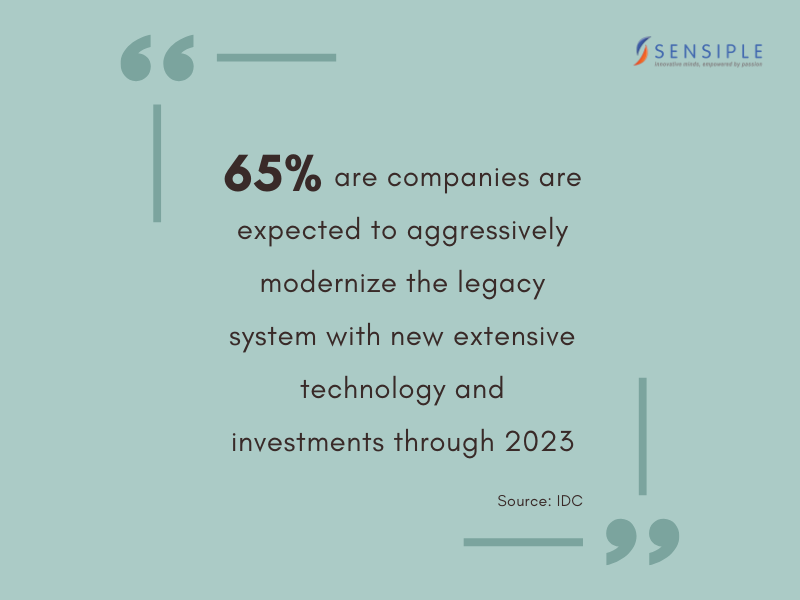
The Business Case for Cloud Application Modernization: Why It's Time to Make the Move
Is your organization struggling to keep up with changing business needs? Are you finding it hard to compete in the market due to outdated legacy systems? The solution that could give your business the turnaround it needs could be ‘Cloud application modernization’.
“Modernizing legacy applications boost 14% of annual revenue which equates to USD 1 billion on average for large organizations”
By updating your legacy applications or building new ones, you can align your applications with your business objectives and improve performance. Innovative cloud technologies that offer automation, scalability, and security can help you enhance the user experience, respond to changing business needs, and gain a competitive advantage in the marketplace.
Why Modernize Traditional Applications with Cloud Modernization?
Modernized applications that run on cloud infrastructure are highly efficient and scalable, which means that you can respond to changing business needs and market conditions. Here are some benefits of moving your applications to the cloud:
Security capabilities
Advanced built-in security features available in major cloud platforms keep organizations assured of data and application safety. Some of the built-in include the automation of tasks for high availability, disaster recovery, backups, and performance monitoring.
Performance efficiency
Cloud’s superior performance capabilities increase your application’s responsiveness and efficiency, making it highly scalable and optimized for speed. It also helps retain current processes and maintain business continuity without wasting time and money from integrating completely new apps into existing operations.
Cost Savings
With application modernization, organizations don’t have to devote all their resources to maintaining applications and infrastructures. They can, in turn, spend the time and money saved on innovating. Also, choosing a trusted partner who does the shift right the first time can significantly reduce the solution’s cost.
Agile and Scalable
Modernized applications enable organizations to allow quick updates and changes to meet business needs seamlessly. It also enables the auto-scaling of apps with a sudden increase in demand. This agile process paves the way for essential elements such as reduced costs with a decrease in demand and a faster time to market.
The Transformative Effects of Cloud Application Modernization:
Many companies across industries are embracing new techniques around IT modernization to turn legacy applications into assets. Here are some typical outcomes that these companies have reported:
- Legacy systems often need higher efforts and resources to be maintained and updated to meet current business needs. Modernizing legacy applications brings about a yearly savings of 15-35% on infrastructure
- Modern applications on the cloud see 74% reduced costs on hardware, software maintenance, and IT personnel
- Modern applications enable businesses to stay competitive amidst rapid technological and cloud advancements
- The increased demand for web and mobile access to applications drives the need for more modernized, responsive, and accessible apps
- Legacy applications are vulnerable to security lags that can be effectively addressed through modernization
- Modernizing applications helps achieve an intuitive and efficient interface and lower application maintenance and running costs by 30-50%
- Modernized applications with increased automation and real-time data can achieve improved business operations and a 10% increase in application operation efficiency
Challenges in Cloud Application Modernization
Cloud Application Modernization offers many benefits for businesses; however, it is also important to be mindful of the typical obstacles that companies may face during the process:
- Legacy application architecture: Many legacy applications were not designed to be cloud-native and cannot easily be moved to a cloud platform. These applications often have monolithic architectures, which can make it difficult to containerize them and scale them effectively
- Data migration: Moving data from on-premises storage to the cloud can be challenging. The data may be in different formats, and it may be difficult to ensure that all data is migrated correctly and securely
- Integration with other systems: Modern applications often need to integrate with other systems, such as third-party APIs, databases, or other cloud services. This integration can be complex, particularly if the systems have different data formats, security requirements, or communication protocols
- Security and compliance: Ensuring that cloud applications are secure and compliant with relevant regulations can be challenging. Organizations need to implement appropriate security measures, such as access controls and encryption, and ensure that their applications meet regulatory requirements
- Application performance: Modern cloud applications need to be fast and responsive to meet user expectations. This can be challenging, particularly if the application needs to scale up or down rapidly to meet changing demand
- Cost optimization: Cloud platforms can offer significant cost savings compared to on-premises infrastructure, but managing cloud costs can be complex. Organizations need to monitor their usage and optimize their resources to ensure they are getting the best value from their cloud investment
- Skills gap: Cloud application modernization often requires specialized skills, such as containerization, microservices architecture, and DevOps. Organizations may need to invest in training or hire new staff to fill these skills gaps
Strategies to Overcome Cloud Application Modernization Challenges
Assess and Plan: Assess the current application status and plan your modernization to help you make a smooth transition to the cloud.
Replace gradually: Start moving small and low-risk applications to the cloud and gradually move larger or more complex ones to reduce disruption.
Verify data security and compliance: Ensure following all applicable compliance requirements and reinforce strong security measures.
Leverage expertise: Rely on cloud app modernization experts who can provide able guidance and support throughout your modernization journey.
Conduct test and validation: Ensure the performance, functionality, and security requirements of the modernized application with tests and validations.
Monitor and improvise regularly: Continuously monitor applications to keep them up-to-date and meet changing business needs.
Supervise technical debts: Address outdated code and architecture to ensure that modernized applications are scalable and maintainable.
By implementing these strategies, you can effectively tackle the obstacles in cloud application modernization and ensure a smooth transition of your applications to the cloud.
Technologies Used for Modernizing Apps
Some of the right kinds of technologies that support organizations in optimizing their IT assets include:
Containers - It brings together application code and seamlessly deploys applications in multiple ecosystems.
Cloud computing - The core technology and the cloud-based tools increase performance and efficiency, which is also easy to use and scale.
Automation - An integral part of app modernization that helps optimize application deployment, networking, scaling, management, and diagnostics.
Microservices - These break complex apps into simple entities and carry deployment separately. Each core function can be built independently, reducing the total time of consumption.
AI and ML - Intelligent services/solutions that help derive rich insights from applications and data.

Stay Ahead of the Curve with Sensiple's Cloud Application Modernization Solutions
Are you eager to stay ahead of the competition and modernize your legacy systems with new technology? According to research, 65% of businesses are expected to aggressively modernize their legacy systems with extensive investments and cloud-based technology by 2023. By choosing to join this trend, you can give your business a competitive edge and ensure it doesn't fall behind. Sensiple's 22+ years of experience in the IT domain and expertise in all major cloud platforms makes us the ideal partner to help you successfully modernize your applications. Whether you require help with legacy application migration, containerization, or microservices architecture, our team of experts can provide tailored strategies to meet your unique needs. Don't wait any longer to elevate your business to new heights with modern, cloud-powered applications. Contact us today to get started.


